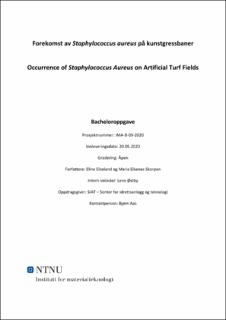| dc.contributor.advisor | Østby, Lene | |
| dc.contributor.advisor | Aas, Bjørn | |
| dc.contributor.author | Eikeland, Eline | |
| dc.contributor.author | Skorpen, Maria Eikenes | |
| dc.date.accessioned | 2020-07-07T16:00:45Z | |
| dc.date.available | 2020-07-07T16:00:45Z | |
| dc.date.issued | 2020 | |
| dc.identifier.uri | https://hdl.handle.net/11250/2661014 | |
| dc.description.abstract | Den første kunstgressbanen innen idrett på verdensbasis ble bygget på 1960-tallet, og siden har kunstgress utviklet seg gjennom fire generasjoner. Tredje generasjons (3G) kunstgress består av kunstgressfibre, sand og gummigranulat, og er mest benyttet både i Norge og på verdensbasis da det ligner naturgress og gir gode spillegenskaper. Til tross for 3G-kunstgressets popularitet, diskuteres miljøaspektet rundt syntetiske fyllmaterialer. Gummigranulat utgjør den nest største kilden til utslipp av mikroplast i norsk natur, og det er derfor av interesse å erstatte syntetiske fyllmaterialer med miljøvennlige materialer. Kunstgress uten kunstig fyllmateriale betegnes som fjerde generasjons (4G) kunstgress, og kan blant annet inneholde organiske fyllmaterialer. På kunstgress har hudlesjoner en hyppigere forekomst sammenlignet med naturgress, som følge av skarpe kunstgressfibre. Hudlesjoner er en smittevei for patogene bakterier som Staphylococcus aureus. Bakterien finnes på hud og i slimhinner hos mennesker, og kan i sjeldne tilfeller forårsake sykdom hos friske personer. Dersom infeksjonen skyldes meticillin-resistent Staphylococcus aureus (MRSA), kan behandling med antibiotika være utfordrende. Mikrobiell vekst på kunstgress kan påvirkes av type fyllmateriale, temperatur, luftfuktighet, CO2-konsentrasjon, ultrafiolett stråling (UV-stråling) og dyprens. Om banene er innen- eller utendørs er også avgjørende. Utendørs kunstgressbaner tilføres mikroorganismer og organisk materiale fra dyr, fugler og nedbør, som kan bidra til biofilmdannelse. Ulike typer fyllmaterialer kan påvirke mikrobiell vekst på kunstgress. Styren-butadiengummigranulat (SBR-granulat) inneholder kjemiske forbindelser som inhiberer mikrobiell vekst, mens hydrofile og porøse organiske fyllmaterialer har en struktur som mikroorganismer og sekreter kan trenge inn i. Den porøse strukturen gir mulighet for biofilmdannelse, og beskytter cellene mot desinfiserende faktorer som kan inhibere mikrobiell vekst. I en praktisk del av oppgaven ble det hentet prøver fra tre områder, A, B og C, på en innendørs kunstgressbane med fyllmateriale av knuste olivenkjerner og sand. Det ble også hentet referanseprøver, R, fra en ubrukt kunstgressmatte av samme type kunstgress som i kunstgresshallen, men uten fyllmateriale. Prøvene ble dyrket på trypticase soy agar (TSA) og inkubert ved 37*C i 43 timer. Det ble observert bakterieoppvekst på 23 av 24 prøver, med variasjon i farge, form og størrelse. Gjennomsnittlig kimtall av prøver for områdene A, B, C og R (relatert til et areal lik 10cm x 10cm), var 3,5 (+/-1,9), 21,7 (+/-17,8) og 6,7 (+/-1,6) og 0,3 (+/-0,5). Resultatene indikerte et bredt spekter av bakterier, samt en tilførsel av mikroorganismer og organisk materiale som spytt og svette fra eksterne kilder. For å kunne undersøke tilstedeværelsen av Staphylococcus aureus burde det utføres en screening av bakterien, noe som ikke ble gjennomført som følge av COVID-19 – pandemien. | |
| dc.description.abstract | The first artificial turf playing field was built in the 1960s, and since then artificial turf fields have been developed through four generations. Third generation (3G) artificial turfs consist of artificial grass fibers, sand and crumb rubber. It is widely used in both Norway and worldwide since it promotes good properties for playing and because of its similarity to natural grass. Despite the popularity of
3G-artificial turfs, the environmental aspect of synthetic infill is discussed. In Norway, crumb rubber constitutes the second largest source to discharge of microplastic in the nature. Therefore, it is of interest to substitute synthetic infills with environmentally friendly products. Artificial turfs without synthetic infill are referred to as the fourth generation (4G) of artificial turfs, with infill such as organic materials. On artificial turfs, the occurrence of skin lesions are more frequent compared to natural grass, as a result of sharp artificial turf fibers. Skin lesions are an entrance for pathogenic bacteria such as Staphylococcus aureus, enabling them to form an infection. The bacterium is located on human skin and in mucous membranes, but can in rare cases cause disease among healthy people. If the infection is caused by methicillin-resistant Staphylococcus aureus (MRSA), treatment by antibiotics can be challenging. Microbial growth on artificial turfs can be influenced by infills, temperature, humidity,
CO2-concentration, ultraviolet radiation (UV-radiation) and deep cleanings. Whether the fields are located in- or outdoors are essential. Microorganisms and organic materials from animals, birds and rainfall are added on outdoor fields, which can promote biofilm formation. Different types of infills can influence microbial growth on artificial turf. Styrene-butadiene rubber granules (SBR-granules) contain chemical compounds that inhibit microbial growth, while hydrophilic and porous organic infill have a structure that microorganisms and secretions can infiltrate. The porous structure enables biofilm formation, and protects the cells from disinfecting factors that may inhibit microbial growth. In a practical part of this study, samples were collected from three areas, A, B and C, from an indoor artificial turf field with crushed olive kerns and sand as infill. Reference samples, R, were collected from an unused artificial turf mat similar to the indoor field, but without infill. All of the samples were grown on trypticase soy agar (TSA) and incubated at 37 *C for 43 hours. Bacterial growth was observed in 23 out of 24 samples, and the colonies varied in color, shape and size. The average colony count of samples collected from the areas A, B, C and R (related to an area equal to 10cm x 10cm) was 3,5 (+/-1,9), 21,7 (+/-17,8), 6,7 (+/-1,6) and 0,3 (+/-0,5). The results indicated a wide range of bacterial growth, as well as a supply of microorganisms and organic materials such as spit and sweat from external sources. To be able to confirm the presence of Staphylococcus aureus, a screening of the bacterium should be carried out. In this study, a screening was planned but not completed due to the
COVID-19 – pandemic. | |
| dc.publisher | NTNU | |
| dc.title | Forekomst av Staphylococcus aureus på kunstgressbaner | |
| dc.type | Bachelor thesis | |
